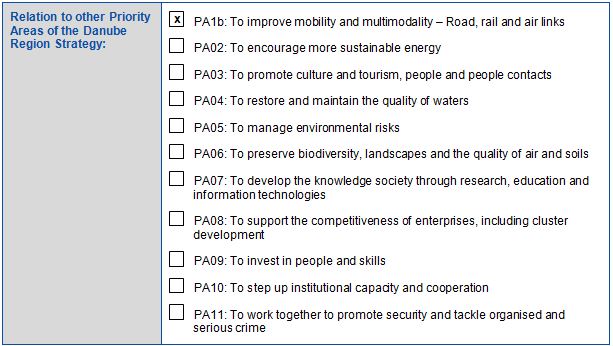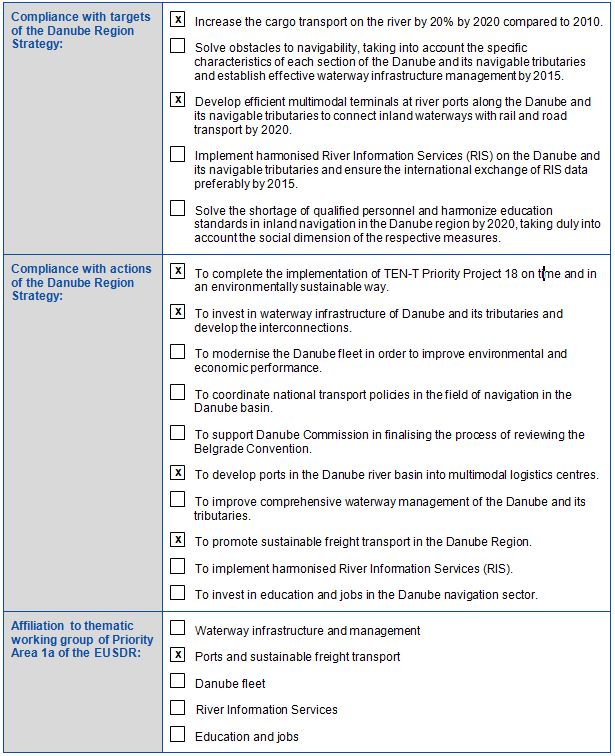BASIC PROJECT DATA – PROJECT IDEA
Project ID: PA1A110
NEED AND ADDED VALUE FOR THE DANUBE REGION STRATEGY
The proposed project represents the construction of multi-modal transport infrastructure required for the deployment of a state-of-the-art-technology terminal for various oil products (hydrocarbons) with a storage capacity of 512.000cbm on the artificial island and the neighbouring shore line in the Port of Constanta.
MAINTopic was not approved for funding under the CEF call which it was submitted to. MAINTopiC only represents a project idea.
Constanta is the main maritime port in Romania, with a strategic location that favours the development of a multi-modal terminal to be used for hydrocarbons. The Port is located on the TEN-T Rhine-Danube core network corridor. Constanta has also the strong point of being the only Black Sea Port with a duty free zone and sufficient water depth to allow the access of heavy tonnage vessels into its basins. The implementation of the proposed project at this location would have had the following results:
- New transport infrastructure developed within Constanta Port & increased connectivity with the hinterland: building 2 new berths, and a quay line of 630 m, building a railway system of 3,75 km on shore, building the road system to connect to the railways on shore and also setting up the road network on the artificial island, connecting the island to the shore line via underwater pipelines and a ferry-boat system
- The application of efficient land-use planning concepts within the port – confining the future oil terminal on the island in order to reduce the impact of incidents and accidental pollution cases on the port community and on the City of Constanta
- Increased capacity of the cargo flow in Constanta Port by 10% – it is estimated that there will be a maritime traffic of 4 million metric tons p.a. and a land traffic of 700.000 metric tons p.a. generated by the multi-modal platform
- Increased quality of the transport & logistics services provided within the port – environmental sustainable, high performance transhipment and storage of hydrocarbons, new transport routes planned & implemented
- Reduction of GHG emissions due to the promotion of environmentally friendly transport modes: railways, pipelines, inland & maritime transport and significant reduction of energy losses due to state of technology technical processes compared to existing old oil terminal
- Increased interoperability of all transport and logistics processes due to the introductions of IT supply chain software designed to serve the island and the shore-line
- Highly skilled workforce – at least 30 people trained in regards to the operation of the multi-modal platform for hydro-carbons and more than 120 trained people operating the oil terminal
The project would have been in line with the general and specific objectives set in the Inter-Modal Strategy Romania 2000 and also those of the General Master Plan for Transport. The objectives of the Constanta Port Master-Plan are also complied with. The Action is included in the list of pre-identified sections and projects stipulated in Annex I, Part I.2 of the CEF-Regulation.
OBJECTIVE(S) OF THE PROJECT
The project was designed to execute the preparatory infrastructure works to transform the artificial island and the neighbouring shoreline into a multi-modal platform for hydrocarbons in the southern part of Constanta Port. The goal was to:
- Maximize the utilization of currently under-used land within the port area: 50 ha of land will be levelled & compacted to ensure the basis for new transport infrastructure
- Building new infrastructure elements (roads, railways, berths, pipes) and making the interconnections in order to enable faster transfer times at higher levels of safety and dramatically reduced losses in energy and consequently lower GHG emissions
- Providing high quality logistics services at competitive prices that are comparable to those offered in Western European terminals
- Shifting cargo to environmentally friendly transport modes by making use of sea transportation and the Danube waterway for hinterland connections
- Stimulate regional economic growth by facilitating high performance logistics services for the entire region and by the induced economic benefits of an investment of approx. 350 million EURO
PLANNED PROJECT ACTIVITIES
As MAINTopic was not approved for funding under the CEF call it was submitted, the following project description will therefore not be implemented and only represents a project idea:
The project should have been divided into 3 activities:
- Activity 1: Project management
- Activity 2: Construction of infrastructure
- Activity 3: Start of operations & evaluations
Activity 1 was foreseen to include all the project management tasks needed for the successful implementation and completion of the project. Dissemination activities were also foreseen in line with the requirements of the funding program.
Activity 2 would have included all the works on the infrastructure elements that are to be developed within the project.
Work would have been split into several sub-activities:
- Detailed technical designs & technical assistance (Sub-activity 2.1)
- Site preparation (Sub-activity 2.2)
- Industrial platform (road & railway infrastructure) (Sub-activity 2.3)
- Maritime Terminal (Sub-activity 2.4)
- Island-Shore connections (Sub-activity 2.5)
Based on the overall technical design for the multi-modal platform, detailed technical designs would have been elaborated for every transport infrastructure element. Proceedings would also have been made in order to acquire the assistance services required for every type of infrastructure during the construction stage.
The artificial island in the Port of Constanta was created when the Danube-Black Sea Canal was excavated in the ridge area (Murfatlar-Agigea). The excavated material was used to make up this new geographic formation that has never been used before for industrial or economic purposes. The shore-line next to the island is in a similar state and both locations require extensive site preparation activities. These relate to levelling & ramming the land. In case of the island additional filling and reinforcement operations would be necessary. Once these steps would have been made, there would also have been preparations needed for starting the works on the transport infrastructure. These would have included installing facilities for the workers, connecting to the energy & water supply network, fencing of the construction site, etc.
Road infrastructure was foreseen to be made available on the island and also on shore. There would have been a truck ramp connecting with the railway infrastructure. A truck parking area was also proposed to be built on shore, in the vicinity of the railway infrastructure elements. The planned roads have a width between 4 and 7 m and their unique transversal slope is 2%.
The railway infrastructure serving the multi-modal platform was proposed to be located on shore. It would have had an overall length of 3.75 km and it should have been directly linked to the railway infrastructure administered by Constanta Port Administration (APM Constanta). The railways would have been divided depending on the type of cargo loaded/unloaded:
- 2 tracks were proposed to be used for unloading operations
- 2 tracks would have been used for loading white products
- 2 tracks would have been used for loading black products
- 1 track would have been used for parking
The waterway infrastructure was proposed to be located on the island. It would have consisted of the building of 2 new berths in the northern side of the island. Additional works performed would have included:
- Capital dredging to ensure a depth of -16 m
- Purchase of loading/ unloading equipment
The two sites making up the multi-modal platform were proposed to be linked by:
1. Underwater cables and pipelines
The pipeline crossing should have been buried in the soil on the port basin bottom, which implies dredging a channel, placing pipelines, filling the ditch, providing a raw stone protection. Anchoring would have been restricted in this area for sea and river vessels.
2. Ferry-boat connection
The ferry-boat would have been used for the transport of employees and also for bringing in supplies & commodities required for the work performed on the island. A mooring berth for the ferry-boat was also foreseen to be built (mooring front 15 linear meters, total length 30 linear meters with a foundation level of – 5 m). A concrete platform would also have been made at this mooring berth. The purchase of the ferry-boat would have been included in the proposed Action.
Activity 3 is focused on the preparatory work performed after the completion of the constructions in order to start the operations. The training of the staff members and the establishment of all internal procedures were foreseen to be dealt with in this activity. In addition to this, several assessments were foreseen in order to establish the socio-economic and environmental impact of the project and thus adjust the next steps needed for the future development of the platform.
TRANSBOUNDARY IMPACT
The port is located on the TEN-T Rhine-Danube core network corridor. The project would have been one of common interest with high relevance for the trans-European transport network:
- The development of multi-modal transport facilities in Constanta area would have ensured that there was a good link between inland & maritime navigation infrastructure, railways and roads, thus supporting the long-distance traffic of goods (e.g. transit of goods from the Far-East to Europe), but also encouraging the distribution of goods at a local and regional level (to the port’s Hinterland made up of the Central and Eastern European countries)
- The infrastructure works foreseen to be built on the island and the shoreline, as well as the connections to be established between them (e.g. underwater pipelines & ferry-boat) would have contributed to bridging the missing links of the port’stransport infrastructure, but also the missing links within the bigger Rhine-Danube corridor.
- Significantly improved transport connections between inland-maritime-rail-road-pipeline would have helped transfer greater cargo quantities in less time and with a smaller impact on the environment. The GHG costs savings will have an impact at local level but also at regional level (Bulgaria, Ukraine, Moldova)
- The multi-modal platform would have been open to all operators in a non-discriminatory way and it shall apply transparent charges
PROJECT BENEFICIARIES / TARGET GROUPS
- Shipping companies
- Port operators
- Forwarding companies
- Equipment suppliers
- Users of hydrocarbons
STATUS AND TIMEFRAME
The project was not realised.
A timeframe of three and a half years had been proposed (2015 – 2018). The project proposal was submitted under the Multi-annual CEF call 2014- Funding Objective 4 – related to the Cohesion Fund. Submission deadline: 26.02.2015.
FINANCING
Total budget: 81,975,000 EUR
EU funds: 69,678,750 EUR (co-funding from CEF was requested but not provided)
Private funds: 12,296,250 EUR (financing not covered by EU grant should have been covered by equity and loan facilities)
The project would not have required public finance due to the concession model.
PROJECT TEAM
Project leader: XTANK REFINING SA
Address: 3, Postelnicului street, Bucharest / Romania
No additional partners would have been involved.
PROJECT ENVIRONMENT
PROJECT CROSS – REFERENCE
The proposed project takes into account the plans included in the following projects that are promoted for implementation by Constanta Port Administration:
- Finishing the offshore dam in Constanta Port –1050 m extension (North breakwater extension) (PA1A055)
- Road Bridge at km 0+540 of the Danube-Black Sea Canal (PA1A057)
- Development of the railway capacity in the fluvial and sea area of Constanta Port (PA1A056)
- Extension to the south of the barge wharf
- Constanta Sud Port development: Bridge over the connection canal in the fluvial and maritime area and connections to the internal and external roads network of the port (PA1A058)
- Finishing the landing stage in the pier 3S (6 new landing stages)
STRATEGIC REFERENCE
The project would have addressed key priorities of the European Union economy and transport policy such as:
- Provision made by the European Union regarding the European Fund for Strategic Investments (EFSI) – An investment Plan for Europe COM 2014/0903 final (“Juncker Plan”). The project fully fulfils the intentions of the EFSI
- Europe 2020 – New Economic Strategy (2010) with highest relevance for the Flagship initiatives: “Innovation Union”, “Resource Efficient Europe”
- The Energy Efficiency Plan 2011: part of the EU’s 20% target aimed at reducing primary energy consumption and the 2020 Energy strategy is focused on: promoting an economy that respects the planet’s resources, improving the EU’s energy independence, implementing a low carbon system;
- A roadmap to moving to a competitive carbon economy in 2050 (2011): the EU should prepare for reductions in its domestic emissions by 80% by 2050 compared to 1990
- White Paper on transport – 2030/2050 perspective (2010): creation of modern infrastructure and multimodality assisted by smart management and information systems, provision of a roadmap to a low carbon transport system and independency from oil and to the objective to shift 30%of road freight over 300km to rail and waterborne transport by 2030 and more than 50% by 2050
RELEVANT LEGISLATION
- The final version of the Romanian Master plan for transport for the short, medium and long term perspective
- Inter-Modal Strategy Romania 2000 which lists the most suitable locations for the development of inter-modal terminals in Romania and also identified the potential beneficiaries for such facilities
- Constanta Port Master-Plan- including a list of all relevant projects to be developed in the port for the short, medium and long term perspective
- Constanta Development Plan – strategic document pre-dating the Constanta Port Master Plan and including the current proposal
EUSDR EMBEDDING
EUSDR COMPLIANCE
OTHER RELEVANT ISSUES
FOLLOW – UP PROJECT
The deployment of the terminal for hydrocarbons including all storage facilities needed for safe and efficient operations. The project would have initiated for future expansions of the platform by performing land-reclamation works on the island which would have been used for investment in ad-joint processing industries, chemical industry and gas industry. The infrastructure investment would also support the realization of a small scale LNG terminal in the Port of Constanta.
ANY OTHER ISSUES
The procedure regarding the concession of the land needed for the development of the multi-modal platform had already been initiated. Constanta Port Administration is the current manager of the land (island & shore-line). This public entity had been working with the Romanian Ministry of Transport in order to launch the tendering procedure for the award of the concession contract regarding the performance of these public works. The concession for the public works is awarded for a period of 49 years. XTANK REFINING SA closely cooperated with Constanta Port Administration for the development of the project. All required technical feasibility studies for the investment into the infrastructure of the terminal have been prepared by XTANK REFINING SA. Several million Euros have been invested in order to bid for the concession.
META DATA
Data provided by: Raluca Danila (Pro Danube International) – 21.8.2017
Download pdf



